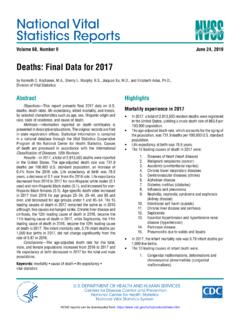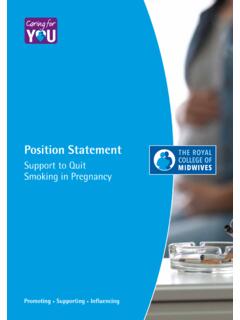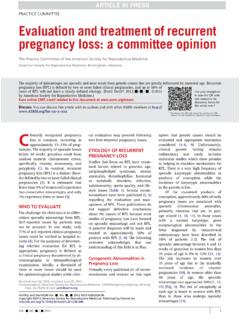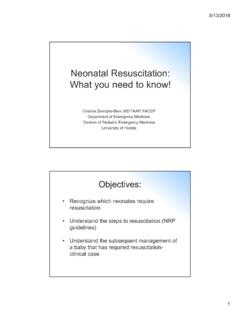Transcription of Guideline on Risk Assessment of Medicinal Products on ...
1 European Medicines Agency Evaluation of Medicines for Human Use 7 Westferry Circus, Canary Wharf, London, E14 4HB, UK Tel. (44-20) 74 18 84 00 Fax (44-20) 74 18 8613 E-mail: European Medicines Agency, 2008. Reproduction is authorised provided the source is acknowledged. London, 24 July 2008 EMEA/CHMP/203927/2005 COMMITTEE FOR Medicinal Products FOR HUMAN USE (CHMP) Guideline ON RISK Assessment OF Medicinal Products ON HUMAN REPRODUCTION AND LACTATION: FROM DATA TO LABELLING DRAFT AGREED BY MULTIDISCIPLINARY EXPERT GROUP June 2005 DRAFT AGREED BY THE SAFETY WORKING PARTY/EFFICACY WORKING PARTY/ PHARMACO-VIGILANCE WORKING PARTY November 2005 DISCUSSION AT THE HERBAL COMMITTEE FOR Medicinal Products (HMPC) MEETING March 2006 ADOPTION BY CHMP FOR RELEASE FOR CONSULTATION March 2006 END OF CONSULTATION (DEADLINE FOR COMMENTS) 30 September 2006 AGREED BY MULTIDISCIPLINARY EXPERT GROUP July 2008 ADOPTION BY CHMP 24 July 2008 DATE FOR COMING INTO EFFECT January 2009 KEYWORDS Pregnancy, lactation, contraindication, non-clinical Assessment , clinical Assessment , risk Assessment , labelling, SPC.
2 2/18 Guideline ON RISK Assessment OF Medicinal Products ON HUMAN REPRODUCTION AND LACTATION: FROM DATA TO LABELLING TABLE OF CONTENTS EXECUTIVE 3 1 INTRODUCTION AND BACKGROUND ..3 2 PURPOSE OF THE Guideline .. 3 3 SCOPE .. 3 4 LEGAL BASIS .. 3 5 NON-CLINICAL 4 Deficiencies in available 5 No effect detected .. 5 Effects detected .. 5 Class alert .. 6 6 CLINICAL 6 Effects on Male and Female Fertility .. 7 Developmental effects:.. 7 Assessment of malformative effects: .. 7 No evidence of increased frequency of malformations .. 8 A suggested or suspected malformative effect is based on: .. 8 A demonstrated malformative effect is defined when:..9 Assessment of fetal and/or neonatal toxicity:.. 9 7 9 8 INTEGRATION: FROM DATA TO 10 General principles .. 10 10 10 11 11 Principles for contraindication in 12 Human 12 Relevant non-clinical studies .. 12 Need for 12 13 Women of childbearing potential / Contraception.
3 13 9 13 APPENDIX 14 APPENDIX 15 APPENDIX 16 3/18 EXECUTIVE SUMMARY Integration of animal and human data to assess the risks of the use of Medicinal Products during pregnancy is a critical task, which is aimed at reducing the induction of birth defects as far as possible. In this document the process of Assessment of non-clinical, animal data is described, followed by guidance on the Assessment of human data. Integration of these assessments is essential for the labelling of a Medicinal product . A decision scheme is provided to determine whether or not a contraindication during pregnancy should be settled in the labelling. Examples of standardized texts are given for recommendations on the use during pregnancy and lactation. 1 INTRODUCTION AND BACKGROUND The information and advice given on how to use a Medicinal product in relation to human reproduction should allow a physician to manage a number of situations.
4 These situations include prescription of Medicinal Products to women of child-bearing potential, pregnant or breast-feeding women. Therefore information on the risks following exposure to the Medicinal product before and during pregnancy, and during lactation should be provided as well as recommendations on the management of risk in clinical practice. The risk Assessment is based on an integrated evaluation of non-clinical and clinical data, which includes consideration of non-clinical pharmacological and pharmacokinetic properties of the Medicinal product , as well as results from non-clinical toxicity studies and of clinical experience. During drug development, and early post marketing period, non-clinical data are of greater importance since clinical experience is still lacking or limited. The clinical data becomes more important as experience grows. For both non-clinical and clinical data, the Assessment should take into account the methodology for data collection, as well as the quality of the data.
5 To allow a proper evaluation ( assess the relevance of findings), the available studies must be of adequate scientific quality. 2 PURPOSE OF THE Guideline The purpose of this Guideline is to: Describe the integration processes of non-clinical and clinical data and highlight the factors of importance for the Assessment of the risk of an adverse reproductive/developmental effect in humans (fertility, pregnancy, health of the foetus and child), based on the Assessment of reproductive toxicity studies in animals and human clinical data, Outline how to communicate the potential or identified risk. Information and recommendations on how to use the Medicinal product are addressed in the Summary of product Characteristics (SPC) of the Medicinal product , taking into account the nature of the risk. 3 SCOPE This Guideline applies to Medicinal Products for human use.
6 4 LEGAL BASIS This Guideline is based on the Directive 2001/83/EC, as amended. With respect to non-clinical data, the Guideline refers primarily to the ICH guidelines on Reproductive Toxicity: Reproductive toxicology: Detection of Toxicity to Reproduction for Medicinal Products Including Toxicity to male fertility (ICH S5A [CPMP/ICH/386/95] and ICH S5B [CPMP/ICH/136/95]), and Toxicokinetics: A Guidance for Assessing Systemic Exposure in Toxicology Studies (ICH S3A [CPMP/ICH/384/95]). With respect to mixed applications reference should be made to the Guideline on the Non-Clinical Documentation for Mixed Marketing Authorisation Applications (CPMP/SWP/799/95) and to the Guideline on Non-Clinical Documentation for Herbal Medicinal Products in Applications for 4/18 Marketing Authorisation (Bibliographical and Mixed Applications) and in Applications for Simplified Registration (EMEA/HMPC/32116/05) The need for clinical data should be considered in line with the Guideline on the Exposure to Medicinal Products during Pregnancy: Need for Post-Authorisation Data (EMEA/CHMP/313666/2005).
7 5 NON-CLINICAL Assessment The non-clinical Assessment should be based on the reproductive toxicity studies and all pharmacological (primary, secondary and safety) and all toxicological data available. Repeated dose toxicity studies can provide important information regarding potential effects on reproduction, particularly male fertility. The aim of the reproductive toxicity studies is to reveal any effect of a Medicinal product on mammalian reproduction. Reproductive toxicity includes: Effects on reproduction in the parental generation: any effects on the male and or female reproductive organs or the related endocrine systems including gamete production and transport, reproductive cycle, sexual behaviour, fertility, gestation, parturition, pregnancy outcomes, lactation, or modification of other functions that are dependent on the integrity of the reproductive system Developmental toxicity: any adverse effect induced in the progeny.
8 This includes effects induced or manifested in the embryonic or foetal period (adverse effect on the conceptus resulting from prenatal exposure) and those induced during the lactation period or manifested postnatally (adverse effect on behaviour and sexual maturation). The following points are important and should be taken into consideration: Choice of species The rat is usually used in all reproductive toxicity studies, whereas the rabbit is usually the second species in the embryo-foetal toxicity study. In cases where the rat or rabbit were considered unsuitable for testing by the applicant, an alternative rodent or non-rodent species should have been considered. In exceptional cases, a second rodent species may be acceptable in embryotoxicity studies, instead of a non-rodent species. At least one of the selected species should be responsive to the primary pharmacodynamic effect of the Medicinal product . Where this has not been possible, the impact of this deficiency should be addressed in the non-clinical overview of the Common Technical Document.
9 Pharmacokinetics: The pharmacokinetic profile including biotransformation should enable an extrapolation of the results from animals to humans, and to assess the relevance of the species selected for testing. For herbal preparations kinetic data should be submitted only if toxicologically relevant constituents have been identified. Information regarding placental transfer and excretion into milk of the Medicinal product and/or its metabolites would be of value for the Assessment . Route of administration: The route of administration should be the route intended for human use. An alternative route may be acceptable if a similar or better pharmacokinetic profile ( resulting in higher exposure) can be demonstrated. Dose in the reproductive toxicity studies: The dose range tested by the applicant should have covered a dose resulting in minimal maternal toxicity such as decreased body weight or food consumption.
10 Whilst it is desirable that a no observed adverse effect level (NOAEL) has been determined, it is more important that dose intervals 5/18 have been close enough to reveal any dose-related trends. If excessive dose intervals have been used there is a risk of missing any teratogenic potential and the study may be rated as insufficient. In developmental toxicity studies, doses causing severe maternal toxicity are not possible to evaluate, since embryofetal adverse effects could be a direct consequence of the Medicinal product or secondary to the poor maternal condition. Toxicokinetics: The exposure in pregnant animals of the compound and/or metabolites should be assessed Mechanism: If reproductive toxicity has been identified, information on the mechanism is desirable. Evaluation process Deficiencies in available data If no non-clinical studies were conducted or if some non-clinical studies are lacking, or some studies are irrelevant, or if data on certain endpoints are lacking, the impact of insufficient data should be addressed in the evaluation and the lack of data should be justified.














